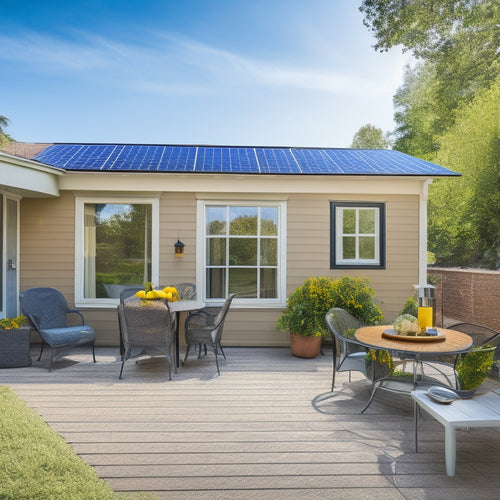
Essential Costs to Budget for Solar Panels on Your Home
Share
When budgeting for solar panels on your home, you'll need to account for several vital costs. The initial installation can range from $15,000 to $30,000, depending on the system's size and quality. You'll also need to take into account the cost of high-efficiency panels, permits, and roof complexity. Inverter replacements, which can occur every 10 to 20 years, will add $2,000 to $5,000 to your overall expense. Additionally, battery backup systems, maintenance, and monitoring systems will require further investment. To guarantee a successful and cost-effective solar panel installation, it's important to understand these vital costs and how they impact your overall investment, which we'll investigate further.
Key Takeaways
- Average residential solar panel system costs range from $15,000 to $30,000, depending on system size and quality.
- Inverter replacement costs can range from $2,000 to $5,000 or more, highlighting the importance of regular maintenance checks.
- Battery backup systems can add $10,000 to $20,000 to the overall cost, but provide grid independence and energy efficiency.
- Regular maintenance, including cleaning and inspections, can cost between $100 to $500 annually to ensure peak performance and longevity.
- Financing options, tax credits, and government rebates can help offset initial investments, making solar panels a more affordable option for homeowners.
Initial Installation Costs
Your solar panel investment begins with the initial installation costs, which can be a significant upfront expenditure. This includes the cost of the solar panels themselves, as well as the necessary equipment, such as inverters and mounting hardware. On average, homeowners can expect to pay between $15,000 and $30,000 for a typical residential solar panel system.
However, you don't need to pay the full amount upfront. Many solar panel providers offer financing options, such as loans or power purchase agreements, to help make the shift to solar more affordable. These financing options can spread the cost of the installation over several years, making it more manageable for homeowners.
The installation timeline typically ranges from a few days to several weeks, depending on the complexity of the project.
Once the installation is complete, you'll be able to start generating electricity and reducing your reliance on the grid. With the right financing options and a well-planned installation timeline, you can make the most of your solar panel investment and start enjoying the benefits of renewable energy.
Solar Panel Quality Variations
As you contemplate financing options and installation timelines, it's equally important to evaluate the quality of the solar panels themselves. The quality of your solar panels can greatly impact their performance and lifespan.
You'll want to reflect on factors such as panel efficiency, which measures how well the panels convert sunlight into electricity. Higher-efficiency panels can generate more power per hour of sunlight, but they often come at a higher cost.
Material durability is another vital aspect to take into account, as it affects the panels' ability to withstand environmental stressors like weather and UV exposure. Look for panels with durable materials, such as tempered glass and anodized aluminum frames, to guarantee they last for decades to come.
Additionally, assess the manufacturer's warranty and reputation, as well as certifications from reputable organizations like the International Electrotechnical Commission (IEC).
Roof Size and Complexity
Most homes have roofs that vary in size and complexity, which greatly impacts the installation and cost of solar panels.
You'll need to evaluate the size of your roof when determining how many solar panels you can fit and how much energy they'll produce. A larger roof means more space for panels, but it also increases the installation cost.
The complexity of your roof is also vital. Roofs with multiple levels, skylights, or unusual shapes require more labor and materials, driving up costs.
Your roof's orientation is also significant, as south-facing roofs receive the most sunlight and are ideal for solar panels. If your roof receives shade from trees or other obstructions, you'll need a shading analysis to determine the impact on energy production.
A thorough roof assessment will help you determine the best solar panel layout and facilitate a successful installation.
Be sure to work with an experienced installer who can accurately assess your roof's unique characteristics and provide a detailed quote for your solar panel system.
Inverter Replacement Costs
When planning your solar panel budget, you'll need to take into account the inverter's lifespan, which typically ranges from 10 to 20 years, depending on the manufacturer and quality.
You should factor in the cost of replacement parts, which can run from $2,000 to $5,000 or more, depending on the type and complexity of the system.
Regular maintenance checks will also be essential to identify potential issues before they become major problems, so be sure to schedule them regularly to avoid costly surprises.
Inverter Lifespan Expectations
Your solar panel system's inverter plays a crucial role in converting DC power into AC power, making it usable in your home. With advancements in inverter technology, you can expect a longer lifespan for your inverter. However, it is important to budget for inverter replacement costs, as they can account for a significant portion of your overall solar panel system expenses.
| Inverter Type | Lifespan Expectations | Efficiency Ratings |
|---|---|---|
| String Inverter | 10-15 years | 95-98% |
| Microinverter | 20-25 years | 95-99% |
| Power Optimizer | 20-25 years | 97-99% |
| Central Inverter | 10-15 years | 95-98% |
When selecting an inverter, consider the lifespan expectations and efficiency ratings. While string inverters are more affordable, microinverters and power optimizers offer longer lifespans and higher efficiency ratings. Central inverters are suitable for larger commercial solar panel systems. By understanding the inverter lifespan expectations, you can better plan for replacement costs and optimize your solar panel system's performance.
Cost of Replacement Parts
Replacing inverter components or the entire unit can be a considerable expense, but understanding the cost of replacement parts helps you plan and budget for these eventualities.
You should factor in the cost of replacing individual components, such as capacitors or fans, which can range from $100 to $500. In some cases, you may need to replace the entire inverter unit, which can cost between $1,000 to $3,000 or more, depending on the quality and brand.
It's crucial to take into account the warranty coverage provided by the manufacturer, as it can greatly impact your replacement costs. Typically, warranties cover inverter components for 5 to 10 years, and some manufacturers offer extended warranty options.
Understanding the replacement frequency of inverter components can also help you budget accordingly. On average, inverters require replacement every 10 to 15 years, although this can vary depending on the quality of the unit and environmental factors.
Scheduling Maintenance Checks
Regular maintenance checks are essential to identify potential issues with your solar panel system's inverter before they become major problems.
You should schedule maintenance checks to guarantee your system operates at its best and extends its lifespan. The maintenance frequency depends on various factors, including the system's age, usage, and environmental conditions.
It's recommended to perform seasonal checks to confirm your system adapts to changing weather conditions.
For instance, spring and fall checks can help optimize system performance during periods of high energy demand.
Professional inspections can identify potential issues before they escalate, saving you from costly repairs or even system failure.
Battery Backup Systems
When considering a solar panel system, you'll want to think about backup power sources, such as battery backup systems, to guarantee you have electricity during grid outages.
You'll need to determine the right system size for your needs, which will depend on factors like your energy usage and the number of days you want the system to provide backup power.
The cost of a battery backup system will vary depending on the size and type of system you choose, but you may be eligible for incentives that can help offset the expense.
Backup Power Sources
Most homeowners who invest in solar panels want a reliable source of power during outages, which is where battery backup systems come into play. These systems provide grid independence, guaranteeing you have energy efficiency even when the grid goes down.
When integrated into your solar panel system, battery backup systems allow you to store excess energy generated during the day for use at night or during outages.
To make the most of your battery backup system, it's vital to educate yourself on its capabilities and limitations. Renewable incentives may be available to offset the cost of your system, and financing options can make it more accessible.
Performance monitoring is important to verify your system is operating efficiently, and utility regulations will impact how you interact with the grid.
As technology advancements continue to improve battery storage, you can expect to see more efficient and cost-effective options emerge.
Considering the environmental impact of traditional energy sources, investing in a battery backup system can be a significant step towards reducing your carbon footprint.
System Sizing Options
You've chosen a battery backup system to secure a reliable source of power during outages, but now it's time to determine the right size for your system. The sizing of your battery backup system directly impacts its efficiency and energy production. A system that's too small won't provide enough power during extended outages, while an oversized system will increase your upfront costs without providing additional benefits.
To determine the ideal size, you'll need to assess your energy requirements during a power outage. Calculate your essential load, which includes the energy required to power critical appliances like refrigerators, medical equipment, and lights.
You'll also need to evaluate the depth of discharge (DOD) of your batteries, as this affects their lifespan and overall system efficiency.
A larger system will provide more energy during extended outages, but it'll also increase your costs. A smaller system will be more cost-effective, but it mightn't provide enough power during prolonged outages.
Cost and Incentives
Investing in a battery backup system requires careful evaluation of the costs involved, as well as the incentives that can help offset them. When budgeting for a battery backup system, you'll want to factor in the upfront costs, which can range from $10,000 to $20,000 or more, depending on the size and type of system you choose.
However, there are financing options available, such as solar leasing, that can help make the system more affordable.
In addition to financing options, you may be eligible for tax credits and government rebates, which can help reduce the overall cost of the system. You'll also want to assess the utility savings you'll enjoy with a battery backup system, which can help offset your energy costs over time.
Plus, you'll be contributing to environmental benefits and increasing your energy efficiency. With net metering, you'll be able to store excess energy generated by your solar panels during the day and use it at night, reducing your reliance on the grid.
Be sure to research the installation timelines and costs associated with your chosen system, as well as the incentives available in your area.
Permits and Inspection Fees
Your solar panel installation requires a green light from local authorities, and that comes at a cost. Before you can start generating clean energy, you'll need to secure the necessary permits from your local government. These permits guarantee that your solar panel system meets safety and building codes.
Typically, you'll need to obtain two types of permits: electrical and building permits. The electrical permit covers the installation of electrical components, while the building permit focuses on the structural integrity of your roof and the solar panel system.
You'll also need to undergo inspection processes, which involve a visual examination of your solar panel system to verify compliance with local regulations.
The cost of permits and inspection fees varies depending on your location and the complexity of your installation. On average, you can expect to pay between $500 to $2,000 for permits and inspections.
While this may seem like an added expense, it's crucial to guarantee the safe and efficient operation of your solar panel system. Be sure to factor these costs into your overall budget to avoid any surprises down the line.
Maintenance and Repair
As solar panels begin generating clean energy, they require regular maintenance to secure peak performance and longevity.
You'll need to budget for routine cleaning to guarantee optimal energy output. Dirty panels can reduce energy production by up to 25%, so it's vital to invest in effective cleaning techniques. You can either hire a professional or invest in a cleaning system, which can cost between $100 to $300 per year, depending on the size of your system.
Regular inspections are also important to identify potential issues before they impact performance. You should budget for an annual inspection, which can cost around $100 to $200. During the inspection, a professional will check for loose connections, damaged panels, and other potential issues that could lead to performance impacts.
Additionally, you should set aside a contingency fund for unexpected repairs, which can cost between $500 to $2,000 or more, depending on the nature of the issue.
Energy Storage Costs
The battery bank, an important component of your solar panel system, requires careful budgeting to guarantee a dependable and efficient energy storage solution. When calculating energy storage costs, contemplate the battery efficiency, which affects the overall system performance.
A well-designed battery bank guarantees energy independence, allowing you to store excess energy generated during the day for use during the night or power outages.
Installation warranties and grid integration capabilities are also significant factors to contemplate. Look for manufacturers offering extensive warranties and seamless grid integration to guarantee a hassle-free experience.
Additionally, take advantage of tax incentives and financing options to offset the initial investment. As you budget for energy storage, remember that technology advancements and system longevity will yield long-term energy savings and a reduced environmental impact.
Monitoring and Tracking Systems
Optimizing your solar panel system's performance relies on accurate monitoring and tracking. This is essential to guarantee you're getting the most out of your investment and maximizing your long-term savings.
A monitoring and tracking system provides you with real-time data on your energy consumption and production, allowing you to make informed decisions about your energy usage.
Some vital features to take into account when selecting a monitoring and tracking system include:
-
User-friendly interfaces: Access performance metrics and real-time data through intuitive user interfaces and mobile apps.
-
System alerts: Receive notifications when issues arise, guaranteeing prompt maintenance and minimizing downtime.
-
Remote monitoring: Keep tabs on your system's performance from anywhere, at any time.
-
Installation integration: Guarantee seamless integration with your existing solar panel system.
-
Customer support: Rely on dedicated customer support for assistance and troubleshooting.
Frequently Asked Questions
Can I Install Solar Panels on a Rented Property?
As you weigh your eco-friendly ambitions, you're wise to contemplate the rented property's strings attached; before installing solar panels, you'll need to secure your landlord's permission, ensuring a harmonious agreement that benefits both you and the property owner.
Will Solar Panels Affect My Roof's Warranty?
You'll want to check if installing solar panels will void your roof's warranty; make certain the installation doesn't compromise roof integrity, and verify warranty coverage remains intact or if new coverage is needed to protect your investment.
Do Solar Panels Work During a Power Outage?
"When in doubt, throw it out" - but not your solar panels! You'll be glad to know that, typically, solar panels don't work during a power outage, as a safety precaution, to prevent energizing dead power lines; however, you can prepare with battery backup systems for continuous power.
Can I Install Solar Panels Myself to Save Money?
You're considering a DIY installation to reap cost savings, but be aware that it may compromise safety and compliance with local regulations, requiring technical knowledge and specific equipment, which may outweigh any potential benefits.
Will Solar Panels Increase My Property Taxes?
Coincidentally, you're wondering if solar panels will enhance your property taxes, right? Well, you'll be relieved to know that, in most cases, the increased solar panel valuation is offset by tax incentives, so your property taxes won't skyrocket - you'll still save in the long run!
Related Posts
-

10 Tips to Buy Affordable Solar Panels Online
When purchasing affordable solar panels online, you'll want to research reputable retailers, compare prices, and chec...
-

Master Advanced Solar Panel Design Online for Free
You can master advanced solar panel design online for free by leveraging specialized courses and training platforms, ...
-

Planning for an Electric Vehicle-Friendly Urban Future
As you plan for an electric vehicle-friendly urban future, you'll need to integrate high-power charging stations, sma...


